Property And Casualty Insurance Classes

Table of Contents
Navigating the World of Property and Casualty Insurance Classes: A Comprehensive Guide
Property and casualty (P&C) insurance is a crucial aspect of safeguarding your assets and mitigating potential financial losses. But with a vast array of insurance classes, understanding the differences and finding the right coverage can feel overwhelming. This comprehensive guide breaks down the key P&C insurance classes, helping you navigate this complex landscape with clarity.
Understanding the Basics: What are Property and Casualty Insurance Classes?
Property and casualty insurance classes are distinct categories that group similar types of risks together. These classifications are used by insurance companies to:
- Assess risk: Insurance companies determine the likelihood of claims and potential costs based on the specific risks associated with each class.
- Set premiums: Premiums are calculated based on the assessed risk level, ensuring a fair price for the coverage provided.
- Manage policies: Insurance classes help streamline policy management and simplify the process of underwriting, claims handling, and policy renewals.
Exploring the Major P&C Insurance Classes: A Detailed Look
Let's delve into the most common property and casualty insurance classes:
1. Personal Lines:
This class encompasses insurance policies designed for individuals and families, covering personal assets and liabilities. Here's a breakdown:
- Homeowners Insurance: Protects your home and personal property from various perils like fire, theft, and natural disasters.
- Auto Insurance: Provides coverage for damage to your vehicle, injuries to others in accidents, and legal liabilities.
- Renters Insurance: Offers protection for personal belongings and liability coverage in case of accidents within your rental property.
- Umbrella Insurance: Provides additional liability coverage beyond the limits of your existing policies, offering broader protection.
2. Commercial Lines:
This class focuses on insurance policies tailored to businesses, covering their operations, assets, and liabilities. Here's a look at some key categories:
- Commercial Property Insurance: Protects commercial buildings, equipment, inventory, and other business assets against various risks.
- General Liability Insurance: Provides coverage for legal liabilities arising from accidents or injuries on business property, products, or services.
- Commercial Auto Insurance: Covers vehicles used for business purposes, including accidents, liability, and damage.
- Workers' Compensation Insurance: Protects employees in case of work-related injuries or illnesses, providing medical care and lost wages.
- Business Income Insurance: Offers financial protection against lost income due to business interruptions caused by insured perils.
3. Specialty Lines:
This class encompasses unique insurance products that cater to specific needs and risks not covered by standard P&C classes. Some examples include:
- Professional Liability Insurance: Protects professionals like doctors, lawyers, and accountants from claims related to negligence or errors in their work.
- Directors and Officers Liability Insurance: Provides coverage for directors and officers of corporations against personal liabilities related to their duties.
- Cyber Liability Insurance: Offers protection against financial losses and legal liabilities stemming from data breaches, cyberattacks, and other online security risks.
- Marine Insurance: Covers ships, cargo, and marine operations against risks associated with sea travel and transportation.
- Aviation Insurance: Provides coverage for aircraft, pilots, and passengers against various aviation risks.
4. Surety Bonds:
While not strictly a P&C insurance class, surety bonds are often categorized alongside them due to their shared risk management principles. These bonds guarantee performance and financial responsibility, offering protection to the bond holder in case of a party's failure to fulfill their obligations. Common surety bonds include:
- Contract Bonds: Guarantee the completion of construction projects or other contracts.
- Fidelity Bonds: Protect employers from financial losses due to employee dishonesty or fraud.
- License and Permit Bonds: Ensure compliance with regulations and licensing requirements.
Selecting the Right P&C Insurance Classes for Your Needs: A Practical Approach
Determining the appropriate P&C insurance classes for your specific needs is crucial. Here are some factors to consider:
- Type of assets: Identify the assets you need to protect, whether it's your home, vehicles, business property, or other valuables.
- Potential risks: Assess the risks associated with your assets, including fire, theft, natural disasters, accidents, and liabilities.
- Legal obligations: Understand any legal requirements for specific types of insurance, such as workers' compensation for businesses.
- Financial capacity: Consider your ability to absorb potential financial losses without insurance coverage.
- Professional advice: Consulting with an insurance broker or agent can provide expert guidance on selecting the most suitable P&C insurance classes for your unique situation.
Off-page SEO considerations:
- Target relevant keywords: Use keywords like "property and casualty insurance classes," "P&C insurance," "insurance types," "risk management," and specific class names (e.g., "homeowners insurance," "commercial liability insurance," "cyber liability insurance").
- Build high-quality backlinks: Reach out to relevant websites (insurance blogs, financial publications, business websites) and request links to this comprehensive guide.
- Promote on social media: Share the article on relevant social media platforms like LinkedIn, Facebook, and Twitter.
- Engage with online communities: Participate in online forums and discussions related to insurance, offering insightful comments and promoting your article.
This comprehensive guide provides a foundation for navigating the world of property and casualty insurance classes. By understanding these classifications and their implications, you can make informed decisions to protect your assets, mitigate financial risks, and secure your future.

Thank you for visiting our website wich cover about Property And Casualty Insurance Classes. We hope the information provided has been useful to you. Feel free to contact us if you have any questions or need further assistance. See you next time and dont miss to bookmark.
Featured Posts
-
Scholzs Coalition Falls Germany Faces Uncertainty
Nov 08, 2024
-
Outer Banks Season 4 Recap Before Part 2
Nov 08, 2024
-
Why Jadon Sancho Didnt Join Chelsea
Nov 08, 2024
-
Tysons Health Scare Before Paul Bout
Nov 08, 2024
-
Sky Atlantic Review The Day Of The Jackal
Nov 08, 2024